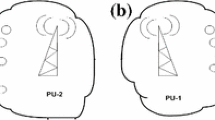Abstract
Cognitive radio (CR) provides a mechanism for effective spectrum usage. Spectrum sensing is an essential component of CR which comprises intelligent signal processing algorithms to identify the spectrum holes. In this paper, we propose a novel soft combining scheme, called mean cumulative sum (MCS), at the cognitive base station or Fusion center (FC), and we have investigated our proposed method through closed form expressions of probability of detection and probability of false alarm, respectively. We have also provided a method of obtaining an optimum threshold to minimize the sensing error which occurs in FC. Our simulation results show that proposed MCS combining scheme outperforms single user spectrum sensing and performs equally well as that of equal gain soft combining scheme. In addition, our results show that sensing error is reduced when optimum threshold is chosen at the FC.








Similar content being viewed by others
References
J.C. Christopher, V.K. Kishore, A. Bagubali, Cognitive radio: spectrum sensing problems in signal processing. Int. J. Comput. Appl. 40(16), 09758887 (2012)
F. Digham, M.S. Alouini, M.K. Simon, On the energy detection of unknown signals over fading channels. IEEE Trans. Commun. 55(1), 21–24 (2007)
S. Enserink, D. Cochran, in 28th Asilomar Conference on Signals, Systems, and Computers. A cyclostationary feature detector (1994), pp. 806–810
G. Ganesan, Y. Li, in 2005 First IEEE International Symposium on New Frontiers in Dynamic Spectrum Access Networks, 2005 (DySPAN 2005). Cooperative spectrum sensing in cognitive radio networks (2005), pp. 137–143
A. Ghasemi, E. Sousa, in 2005 First IEEE International Symposium on New Frontiers in Dynamic Spectrum Access Networks, 2005 (DySPAN 2005). Collaborative spectrum sensing for opportunistic access in fading environments (2005), pp. 131–136
S. Haykin, Cognitive radio: brain-empowered wireless communications. IEEE J. Sel. Areas Commun. 23(2), 201–220 (2005)
S.M. Kay, Fundamentals of Statistical Signal Processing: Detection Theory (Prentice-Hall, Englewood Cliffs, 1998)
J. Ma, Y. Li, in Global Telecommunications Conference, 2007 (GLOBECOM ’07). Soft combination and detection for cooperative spectrum sensing in cognitive radio networks (IEEE, 2007), pp. 3139–3143
J. Ma, G. Zhao, Y. Li, Soft combination and detection for cooperative spectrum sensing in cognitive radio networks. IEEE Trans. Wirel. Commun. 7(11), 4502–4507 (2008)
J. Mitola, J. Maguire G.Q., Cognitive radio: making software radios more personal. IEEE Pers. Commun. 6(4), 13–18 (1999)
A. Papoulis, P. Unnikrishna, Probability, Random Variables, and Stochastic Processes, 4th edn. (TATA McGraw-Hill, New York, 2006)
Spectrum policy task force, Report of the spectrum efficiency working group. Tech. rep., Federal Communications Commission (2002)
E. Visotsky, S. Kuffner, R. Peterson, in 2005 First IEEE International Symposium on New Frontiers in Dynamic Spectrum Access Networks, 2005 (DySPAN 2005). On collaborative detection of tv transmissions in support of dynamic spectrum sharing (2005), pp. 338–345
H. Zhang, Y. Shi, M. Liu, H1; step tracking control for networked discrete-time nonlinear systems with integral and predictive actions. IEEE Trans. Ind. Inform. 9(1), 337–345 (2013)
H. Zhang, Y. Shi, A. Mehr, Robust static output feedback control and remote pid design for networked motor systems. IEEE Trans. Ind. Electron. 58(12), 5396–5405 (2011)
H. Zhang, Y. Shi, A. Saadat, Robust H1 PID control for multivariable networked control systems with disturbance/noise attenuation. Int. J. Robust Nonlinear Control 22(2), 183–204 (2012)
H. Zhang, Y. Shi, A. Saadat Mehr, Robust energy-to-peak filtering for networked systems with time-varying delays and randomly missing data. IET Control Theory Appl. 4(12), 2921–2936 (2010)
H. Zhang, Y. Shi, A. Saadat Mehr, H. Huang, Robust FIR equalization for time- varying communication channels with intermittent observations via an LMI approach. Signal Process. 91(7), 1651–1658 (2011)
H. Zhang, Y. Shi, A.A. Saadat Mehr, Robust weighted H1 filtering for networked systems with intermittent measurements of multiple sensors. Int. J. Adapt. Control Signal Process. 25(4), 313–330 (2011)
W. Zhang, R. Mallik, K. Letaief, Optimization of cooperative spectrum sensing with energy detection in cognitive radio networks. IEEE Trans. Wirel. Commun. 8(12), 5761–5766 (2009)
Author information
Authors and Affiliations
Corresponding author
Appendices
Appendix 1
Proof for optimum threshold
where \(erf(\cdot )\) is an error function. Using the relation \(\frac{d}{\mathrm{d}x}erf(x) = \frac{2}{\sqrt{\pi }}\exp ^{-x^2}\), and after substituting from (8), (9), (10) and (11), the above equation becomes
taking natural logarithm on both sides, and solving the quadratic equation for \(\Lambda \), we get optimum threshold as,
where we let \(X \!=\! 2M\left( 1\!+\!2\gamma \right) \left( \dfrac{2N^2\!+\!3N\!+\!1}{6N}\right) \ln \left( \sqrt{1\!+\!2\gamma }\right) \!+\! \left( \dfrac{M\left( 1\!+\!N\right) \gamma }{2}\right) ^2\)
Appendix 2
Proof for convexity of \(P_e\)
We continue from our previous derivation to find \(\dfrac{\mathrm{d}^2P_e}{\mathrm{d}\Lambda ^2}\) as,
From (8), (9), (10) and (11), we know that \(\mu _{H_1}>\mu _{H_0}, \Sigma _{H_1}>\Sigma _{H_0}\), and in addition \(\Sigma _{H_1}>\mu _{H_1}\). Therefore, the second derivative is \(\dfrac{\mathrm{d}_e}{\mathrm{d}\Lambda ^2} \ge 0\). Hence, the function \(P_e\) is convex.
Rights and permissions
About this article
Cite this article
Sriharipriya, K.C., Baskaran, K. Collaborative Spectrum Sensing of Cognitive Radio Networks with Simple and Effective Fusion Scheme. Circuits Syst Signal Process 33, 2851–2865 (2014). https://doi.org/10.1007/s00034-014-9768-7
Received:
Revised:
Accepted:
Published:
Issue Date:
DOI: https://doi.org/10.1007/s00034-014-9768-7




